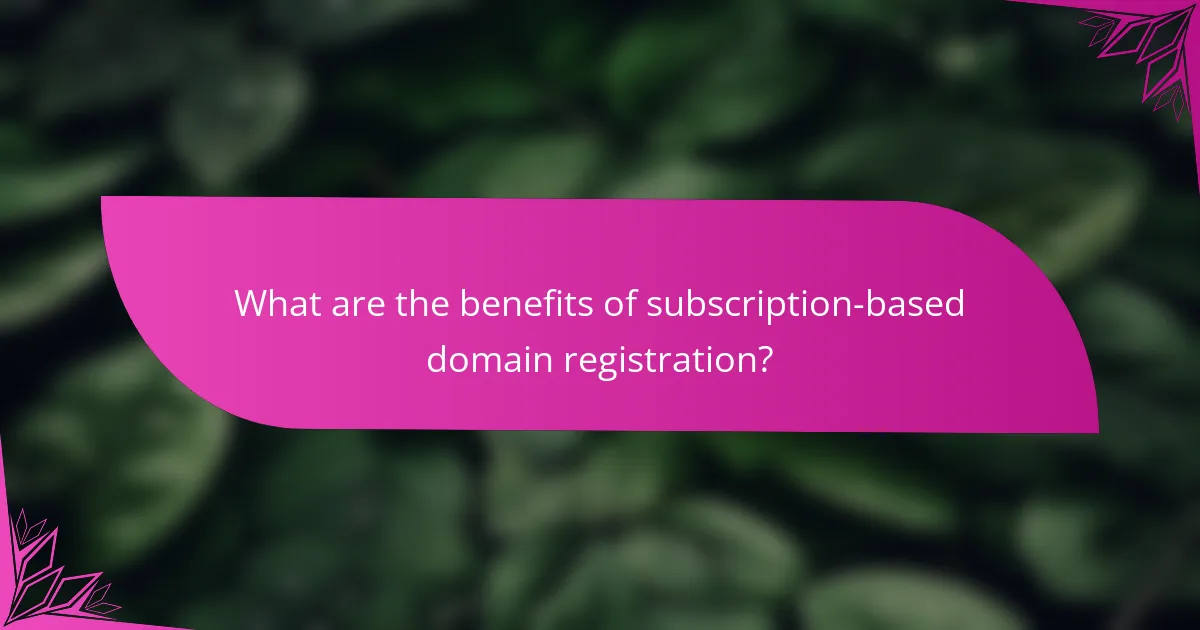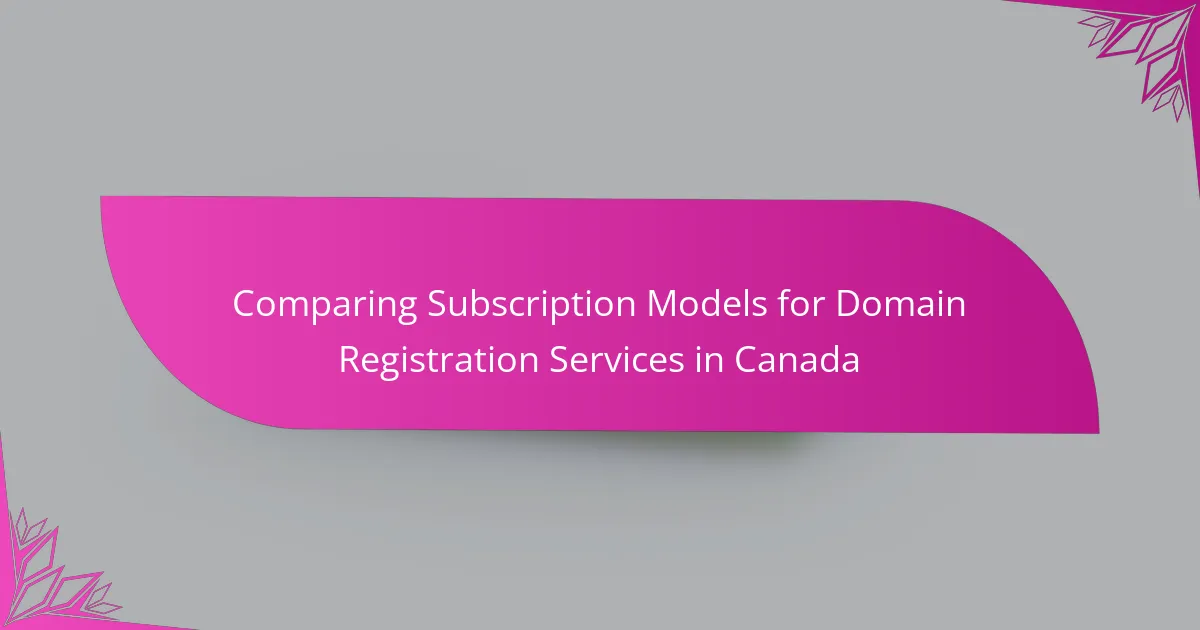When choosing a domain registration service in Canada, understanding the various subscription models—annual, monthly, and tiered—is crucial for making an informed decision. Each model presents unique benefits and considerations that cater to different needs and budgets, impacting both initial costs and renewal fees. By comparing these options, users can find the most cost-effective and convenient solution for securing their online presence.

What are the best subscription models for domain registration in Canada?
The best subscription models for domain registration in Canada include annual, monthly, and tiered options. Each model has distinct advantages and considerations depending on your needs, budget, and how long you plan to maintain your domain.
Annual subscription model
The annual subscription model involves paying for domain registration for a full year upfront. This model often provides the best value, as many registrars offer discounts for long-term commitments, typically ranging from 10% to 30% off the standard rate.
For example, if a domain costs $15 per year, an annual subscription might only require a payment of $10 to $12 if you commit for multiple years. This model is ideal for businesses or individuals who plan to keep their domain for the long term.
Monthly subscription model
The monthly subscription model allows users to pay for domain registration on a month-to-month basis. This flexibility can be beneficial for startups or projects that may not need a domain for an extended period.
However, this model typically comes with a higher overall cost, as registrars may charge a premium for the convenience of monthly payments. For instance, a domain that costs $15 annually might be priced at $2 per month, totaling $24 over a year.
Tiered subscription model
The tiered subscription model offers different levels of service based on the features included, such as additional storage, email accounts, or privacy protection. This model allows users to choose a plan that best fits their needs and budget.
For example, a basic tier might include just domain registration for around $10 per year, while a premium tier with added features could cost $50 or more. This model is suitable for users who want to scale their services as their needs grow.

How do pricing structures vary among domain registrars?
Pricing structures for domain registration services in Canada can differ significantly among registrars, affecting initial costs, renewal fees, and additional services. It’s essential to compare these factors to find the best value for your needs.
GoDaddy pricing overview
GoDaddy typically offers competitive pricing for initial domain registrations, often starting around $10 to $20 per year for standard domains. However, renewal rates can be higher, sometimes exceeding $20 annually, depending on the domain extension.
In addition to domain registration, GoDaddy provides various add-ons such as privacy protection and web hosting, which can increase overall costs. Be cautious of promotional pricing that may not apply upon renewal.
Namecheap pricing overview
Namecheap is known for its affordable pricing, with initial domain registrations often available for as low as $8 to $15 per year. Renewal fees are generally more stable, making it easier to budget for long-term ownership.
Namecheap also includes free WHOIS privacy protection with many of its domains, adding value without extra costs. This can be a significant advantage for users concerned about privacy and data protection.
Bluehost pricing overview
Bluehost’s domain registration prices usually range from $10 to $25 per year, depending on the domain type. They often bundle domain registration with their web hosting services, which can be a cost-effective option for new website owners.
While Bluehost offers competitive initial pricing, it’s important to review their renewal rates and any additional fees for services like domain privacy. Users should ensure they understand the total cost of ownership before committing.

What are the benefits of subscription-based domain registration?
Subscription-based domain registration offers several advantages, including cost efficiency and convenience. By opting for a subscription model, users can secure their domain names for extended periods while enjoying additional features that enhance their online presence.
Cost savings over time
One of the primary benefits of subscription-based domain registration is the potential for cost savings. Many providers offer discounted rates for longer subscription periods, allowing users to save compared to annual renewals. For instance, registering a domain for multiple years might reduce the average annual cost by 10-20%.
Additionally, subscription plans often include bundled services, such as hosting or email accounts, which can further lower overall expenses. This approach helps businesses manage their budgets more effectively while ensuring they maintain their online identity.
Automatic renewal features
Automatic renewal is a key feature of subscription-based domain registration that helps prevent the accidental loss of a domain. When a subscription is active, the domain is automatically renewed at the end of the term, ensuring continuous ownership without the need for manual intervention.
This feature is particularly beneficial for businesses that rely heavily on their online presence, as it mitigates the risk of downtime or loss of brand identity. Users should, however, monitor their payment methods to avoid disruptions due to expired credit cards or insufficient funds.
Access to premium services
Subscription models often provide access to premium services that enhance the functionality and security of a domain. These may include advanced DNS management, enhanced security features like SSL certificates, and professional email addresses, which can significantly improve a brand’s credibility.
For example, some providers offer website builders or marketing tools as part of their subscription packages, allowing users to create and manage their online presence more effectively. Evaluating these additional services can help businesses choose a plan that aligns with their needs and growth objectives.

What factors should you consider when choosing a subscription model?
When selecting a subscription model for domain registration services, consider pricing, renewal rates, and included features. Evaluating these factors helps ensure you choose a plan that meets your needs without incurring unexpected costs.
Registrar reputation
The reputation of a domain registrar is crucial in determining the reliability and quality of their services. Look for registrars with positive reviews and a history of good customer experiences. Websites like Trustpilot or the Better Business Bureau can provide insights into a registrar’s standing.
Additionally, consider how long the registrar has been in business. Established companies often have a proven track record, while newer registrars may offer competitive pricing but lack extensive customer feedback.
Customer support quality
High-quality customer support is essential when issues arise with your domain registration. Look for registrars that offer multiple support channels, such as phone, email, and live chat, and check their availability hours. A registrar with 24/7 support can be particularly beneficial for urgent matters.
Evaluate response times and the effectiveness of their support by reading customer reviews. A registrar that resolves issues quickly and efficiently can save you time and frustration in the long run.
Service features comparison
Different subscription models come with varying features that can impact your domain management experience. Common features to compare include domain privacy protection, email forwarding, and DNS management tools. Some registrars may bundle these features into their plans, while others may charge extra.
Consider your specific needs when evaluating features. For example, if you require multiple domains or advanced DNS settings, choose a plan that accommodates those requirements without excessive fees. A comparison table can help visualize these differences effectively.

How do renewal rates impact subscription choices?
Renewal rates significantly influence subscription choices for domain registration services in Canada. Higher renewal fees can lead to increased long-term costs, prompting users to carefully evaluate their options before committing to a provider.
Impact of renewal fees
Renewal fees are the costs incurred when a domain name is renewed after its initial registration period. Many registrars offer low introductory rates, but these can spike significantly upon renewal. For example, a domain that starts at $10 per year may renew at $20 or more, impacting your overall budget.
It’s essential to read the fine print of any subscription model to understand the renewal fees. Some providers may offer fixed renewal rates, while others may adjust prices based on market trends or demand.
Long-term cost analysis
When evaluating domain registration services, consider the long-term costs associated with renewal rates. A low initial price might seem attractive, but if the renewal fees are high, the total expenditure over several years can be substantial. For instance, a domain registered for three years at $10 per year, with a renewal fee of $25, results in a total cost of $85.
To make an informed decision, compare the total costs of different providers over a span of three to five years. Look for registrars that offer transparent pricing structures and consider locking in renewal rates if possible to avoid unexpected increases.

What are the risks of subscription domain registration?
Subscription domain registration carries several risks that can affect ownership and service continuity. Users should be aware of potential loss of domain ownership and the possibility of service discontinuation, both of which can lead to significant disruptions.
Loss of domain ownership
With subscription models, there is a risk of losing ownership of your domain if you fail to maintain your subscription. If payments are missed or if the service provider goes out of business, you may lose access to your domain name, which can impact your online presence.
To mitigate this risk, ensure that you keep track of renewal dates and payment schedules. Consider setting up automatic payments or reminders to avoid lapses in service. Additionally, review the terms of service to understand the conditions under which ownership may be forfeited.
Service discontinuation risks
Subscription domain registration services can face discontinuation due to various reasons, such as financial instability or changes in business strategy. If a provider ceases operations, your domain may become inaccessible, leading to potential downtime for your website.
To protect against this risk, diversify your domain registrations across multiple providers or consider using a more established registrar with a solid track record. Regularly back up your domain information and keep contact details updated to ensure you receive any important notifications from your provider.
